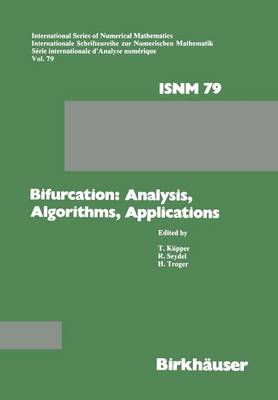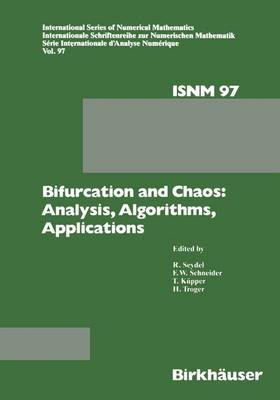International Series of Numerical Mathematics
2 primary works
Book 79
Bifurcation: Analysis, Algorithms, Applications
by KUEPPER, SEYDEL, and TROGER
Published 1 January 1987
The conference on BIFURCATIONS: ANALYSIS, ALGORITHMS, APPLICATIONS took place in Dortmund in August 18 - 22, 1986. More then 150 Scientists from 16 countries participated in the meeting, among them mathematicians, engi neers, and physicists. A broad spectrum of new results on bifurcation was covered by 49 talks. The diversity of the range of treated topics and of involved fields inspired fruitful discussions. 36 refereed papers are contained in these proceedings. The subjects covered treat bifurcation problems, ranging from theoretical investigations to numerical results, with emphasis placed upon applications. The more theoreti cal papers include the topics symmetry breaking, delay differential equations, Cornu spirals, homoclinic orbits, and selfsimilarity. Different kinds of bifurcations are treated: Hopf bifurcation, bifurcation from continuous spec trum, complex bifurcation, and bifurcation near tori. Several numerical as pects are discussed, among them continuation, block elimination, and spectral methods. Algorithms are proposed for approximating manifolds, calculating pe riodic solutions and handling multi-parameter problems. Ample space is devoted to· applications. Classical phenomena from fluid mechanics (such as convection rolls and th~ Taylor vortex problem), buckling, and reaction-diffusion pro blems are considered. Other applications of bifurcations include railway vehicle dynamics, computer graphics, semiconductors, drilling processes, simu lation of oil reservoirs, and rotor dynamics. The proceedings reflect current research in bifurcation. They are an attempt to bring together researchers from differ~nt disciplines to stimulate common effort towards a better understanding and handling of bifurcation pro blems.
Book 97
Bifurcation and Chaos: Analysis, Algorithms, Applications
by KUEPPER, Schneider, SEYDEL, and TROGER
Published 14 June 2012
This volume contains the proceedings of a conference held in Wiirzburg, August 20-24, 1990. The theme of the conference was Bifurcation and Chaos: Analysis, Algorithms, Ap plications. More than 100 scientists from 21 countries presented 80 contributions. Many of the results of the conference are described in the 49 refereed papers that follow. The conference was sponsored by the Deutsche Forschungsgemeinschaft, and by the Deutscher Akademischer Austauschdienst. We gratefully acknowledge the support from these agen cies. The science of nonlinear phenomena is evolving rapidly. Over the last 10 years, the emphasis has been gradually shifting. How trends vary may be seen by comparing these proceedings with previous ones, in particular with the conference held in Dortmund 1986 (proceedings published in ISNM 79). Concerning the range of phenomena, chaos has joined the bifurcation scenarios. As expected, the acceptance of chaos is less emotional among professionals, than it has been in some popular publications. A nalytical methods appear to have reached a state in which basic results of singularities, symmetry groups, or normal forms are everyday experience rather than exciting news. Similarly, numerical algorithms for frequent situations are now well established. Implemented in several packages, such algorithms have become standard means for attacking nonlinear problems. The sophisti cation that analytical and numerical methods have reached supports the vigorous trend to more and more applications. Pioneering equations as those named after Duffing, Van der Pol, or Lorenz, are no longer exclusively the state of art.

